by Winding Pathways | Feb 27, 2025 | (Sub)Urban Homesteading, Energy Efficiency, Trees/Shrubs
After lots of experimenting, we’ve figured out how to create the best woodstove fire.
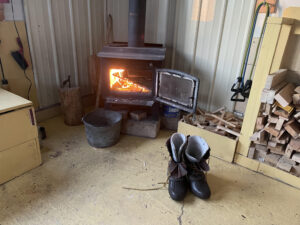
Wood heat is lovely
For a half century, our stoves kept us warm during winter’s chill. We’ve burned all sorts of wood, ranging from rather low-heat cottonwood to heat-dense black locust. We prefer using a mix of wood from different species to create and maintain the best warming fire.
Sources
The Internet is packed with charts giving the relative heat value of wood based on species. These are great resources that help choose the best wood species. All the charts assume that every species is dried to about the same moisture contact to make accurate comparisons. When given a choice it’s generally the best use of time and storage space to choose dense woods that have high heat value. But we make great use of lower-value woods like pine and cottonwood.
Curing
No matter the species, wood needs to be cured to make efficient firewood. We cut and split our wood and store it out of the rain for at least two years.
Trees Felled
In August 2020 a derecho’s 140 mile an hour wind felled 47 trees on our property. It made a mess. We hated losing shade and privacy but converted the downed trees into cordwood that’s kept us warm for the past four winters. The wind knocked down Douglas Fir, Black and Red Oak, Mulberry, Black Cherry, White Pine, Hackberry and American Elm. We use them all in slightly different ways.
Different Woods
Here’s how different types of wood burn and how to take advantage of their different characteristics.
Woods with Pitch
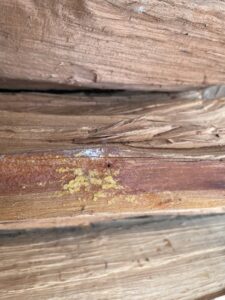
Douglas Fir has lots of pitch.
Pine and Douglas Fir: These softwoods contain pitch. Highly flammable turpentine is made from pine pitch. It burns like crazy. We split our White Pine into kindling. Finely split shavings are easy to light with a match even without using paper. Once the fire is going, we avoid burning smoky pine.
Our Douglas Fir is denser and harder than pine and holds more heat per pound. It also contains pitch. So, when starting a fire on a cold morning we put a large chunk of Douglas Fir in the woodstove, lean pine shavings against it, and strike a match. Soon the shavings are burning hot enough to ignite the Fir’s pitch and get a hot fire started.
Putting too much kindling or pitch-filled wood in a stove can be dangerous. It burns very hot with a yellow flame and some smoke. So, we don’t load the firebox with the stuff.
Hardwoods
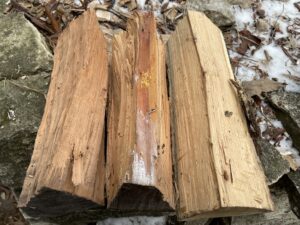
Three types of hardwood.
Oak, Cherry, Hackberry, and Elm: These hardwoods lack pitch but are loaded with heat released during combustion. We put these woods on our chunk of burning Douglas Fir and keep adding them all day. They create a mellow burn that releases heat more slowly than softwoods. The Engineering Toolbox has excellent information on relative values of wood heat.
Relative Heat Values
Here are some relative heat values of the woods we burn.
Species BTU’s Per Cord Cord Weight
Red Oak 24 million 3760
Black Cherry 20 .. 3520
White Pine 14.3 .. 2240
Douglas Fir 26.4 .. 2970
Cottonwood 15.8.. 2272
Benefits of woodstoves
Burning wood saves money and provides ultra-comfortable heat, but it takes plenty of work to find, cut, split, move, and stack it. Then it has to cure and be moved close to the stove. To us, the work and patience have been well worth it, especially on frigid snowy nights.
-
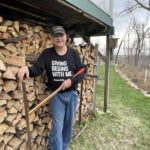
-
Summer project.
-
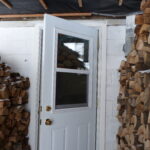
-
Storing wood.
by Winding Pathways | Feb 20, 2025 | Mammals
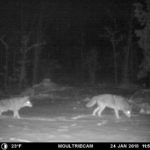
Night activity
Coyotes have moved into town. They’re showing well within huge cities and towns from the Atlantic to the Pacific. Sometimes early news reports of urban coyotes bring concern among residents. Are they dangerous? If you listen to media or follow social media then you might reach one conclusion. And, if you use logic you come to a more reasonable conclusion.
Long Relationship With Coyotes
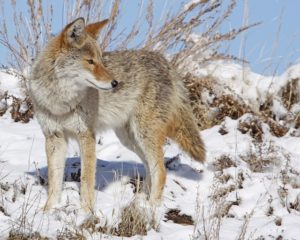
Coyotes are secretive creatures.
Our relationship with coyotes goes back decades. In the fall of 1971 Rich worked for a farm chemical company in Idaho, delivering fertilizer to wheat farms. One day after he and a farmer unloaded the truck, they sat on the tailgate eating lunch. Across the harvested wheat field, a coyote emerged from the woods and pranced along the field’s edge. Although he was far away, we saw him successfully catch a tiny animal, probably a mouse.
The farmer said, “There goes my best employee. That coyote works night and day catching mice that eat my crops. He never complains, doesn’t expect a paycheck, and completely takes care of himself.”
Coyote Expansion
Back then coyotes mostly lived in rural areas from the Midwest to the Pacific Ocean and north to the Arctic. They never abandoned their rural roots, but over the years enterprising coyotes moved into towns and cities and expanded their range to the Atlantic. Now they’re common across nearly all of North America. Although rarely spotted, coyotes have moved into town.
Adaptable Coyotes
Coyotes are amazingly cunning and adaptable animals. Their much larger cousins, timber wolves, were trapped and shot to extirpation in most areas. Despite centuries of human persecution, coyotes kept expanding. Unlike wolves, they learned to adapt to living in close proximity to humans.
Local Coyotes
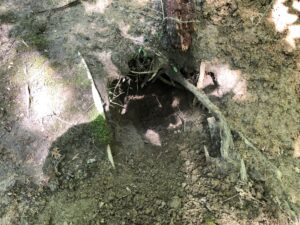 For many years a coyote pair maintained a den and raised litters of pups in a den about 300 yards from our house. We don’t see them often but spot their tracks crossing our lawn after a new snow. Every once in a while, a distant ambulance or police siren warns motorists to pull over. Often “our” coyotes respond by singing just after the siren stops. Sometimes they yip and yap with no obvious triggering sound. We love hearing them. YouTube has many videos of coyotes howling.
For many years a coyote pair maintained a den and raised litters of pups in a den about 300 yards from our house. We don’t see them often but spot their tracks crossing our lawn after a new snow. Every once in a while, a distant ambulance or police siren warns motorists to pull over. Often “our” coyotes respond by singing just after the siren stops. Sometimes they yip and yap with no obvious triggering sound. We love hearing them. YouTube has many videos of coyotes howling.
Diet
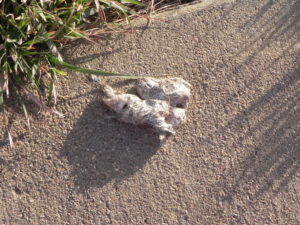
Tell tale sign of coyotes
Although a coyote’s favorite meal is a mouse, cottontail, or other small mammal, they enjoy a varied diet that can include fruit, dead roadside animals, discarded pizza slices in an urban alley, and a host of other goodies.
Are Coyotes Dangerous to People?
Everything’s relative. Since 340 million Americans live close to coyotes it’s amazing how few incidents occur. They do happen, with the highest number of coyote bites happening in California. For detail check out publications at Urban Coyote Research Project.
Contrast that with deaths caused by dogs. Their bites cause an average of 43 human fatalities a year.
Are They Beneficial
They sure are. Drive through suburbia on a June evening and odds are that juvenile cottontail rabbits are hopping on lawns, in gardens, and across roads. Do the same drive in the fall and only an occasional bunny may be sighted. If left unchecked both rural and urban areas would be overrun with mice, rabbits, voles, and rats. Thank coyotes and owls, hawks, and foxes for keeping prey numbers at a low enough level to make gardening possible,
How In the World is “Coyote” pronounced
We prefer the Idaho pronunciation “coyOTE” with two syllables. Others say coyoTEE with three syllables. Take your pick.
Back to the story of the farmer. After he spotted the coyote stalking mice in his field he yelled out, “Thanks, fella. Keep up the good work!” Anyone might say the same when they spot a coyote anywhere……but be cautious. Never approach one closely, particularly if it seems ill or injured. Keep a distance away. Usually, it will slink off as soon as it spots a person.
by Winding Pathways | Feb 13, 2025 | Mammals, Nature
Beavers moved into town. Even a large city like Cedar Rapids.
Surprise
An amazing sight greeted us In December 2024, as we walked a circular trail around a tiny unnamed stream in the heart of Cedar Rapids, Iowa. A beaver dam spanned the narrow waterway. Beaver-felled trees lined the bank while bark-peeled branches floated in the still water.
Nearby were two busy roads, houses, and apartment buildings. Tall downtown buildings were just a mile away. So were factories. These beavers are urban.
-

-
Cedar Lake, Cedar Rapids, Iowa.
-
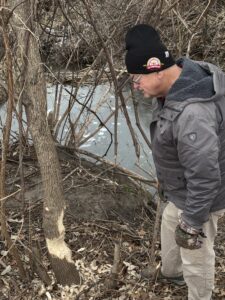
-
A beaver chew next to urban stream.
Urban Beavers
Beavers in a city of 140,000 people! 100 years ago, no one would have imagined that beavers moved into town. But today North America’s largest rodent has moved into cities across the continent. They thrive despite noise and human activity.
Watching City Beavers
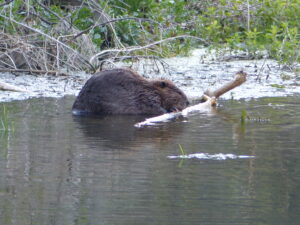
Chewiing
Lots of people enjoy urban birding, and beaver-watching is just as fun. Their territory is easy to find. Fetch a lawn chair, dress warmly, bring binoculars, and perch within sight of beaver activity in the early morning or late afternoon when they’re likely most active.
What to Look For
No animal leaves such visible and durable calling cards as does a beaver family. We walk trails along rivers and often spot trees felled by the sharp teeth and powerful jaw muscles of ambitious beavers. They relish eating the thin nutritious bark covering branches. Beavers leave so much debris around it’s hard to miss finding an active colony.
-
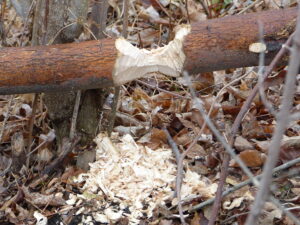
-
chips
-
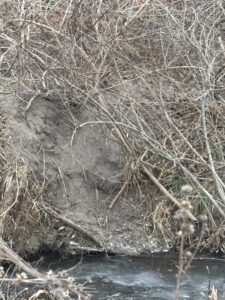
-
Beavers slide
While waiting for beavers to appear keep your eyes peeled. Beavers are a keystone species that alters its environment by cutting trees, digging den holes in the bank, and backing up streams. Their activity attracts many other species, including muskrats, mink, and a host of songbirds that frequent the water’s edge.
An Amazing Resurgence Follows Sad Exploitation
When early Europeans crossed the Atlantic, they found a beaver-filled continent. Experts guess there were somewhere between 60 million and 400 million of the furry animals from coast to coast. That soon changed. European beavers had been hunted and trapped for ages and weren’t common, so newly arrived Americans almost immediately began trapping the huge rodents.
Legendary mountain men combed the Rockies to find plentiful beavers and hundreds of thousands of pelts were shipped eastward in canoes by Canadian voyageurs. Many were shipped to Europe. In the days before synthetic insulation fur kept people warm, and fashionable beaver hats were made from their hair.
Decline and Ethics
The fur trade lasted about 250 years until the late 1800s when the animals had been extirpated from vast parts of their original range. Then came happier news. The value of beaver pelts sank as hats went out of fashion, trees rebounded along streams, and new conservation laws and ethics arose. That started a slow comeback, and now beavers seem to be everywhere.
Two Species
There are two beaver species – the North American and Eurasian. Both are similar but the Old-World species is slightly larger. Each species has made a dramatic comeback. American beavers were released in Finland and Patagonia, where they now thrive as invasive species.
Where Are the Beaver Dams?
Children love reading books about beavers and know that they build dams. Well, not always. These ambitious animals are smart. If their pond, lake, or river is deep enough there’s no need to build a dam. They simply tunnel into the bank to create a home or, sometimes, build a dome-shaped house of sticks and mud that’s usually easy to spot.
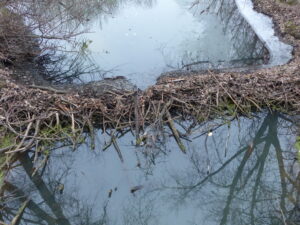
Crossing a small stream.
However, if their stream is narrow and shallow beavers spend nights changing it. They’ll build an amazingly sturdy and often long dam spanning the stream, creating water deep enough for good swimming and hiding a bank tunnel entrance below the surface. Beavers are engineers.
Easy to Watch Urban Beavers
Years ago, beavers were hard to find, even in rural areas. Not anymore. They’re so common in urban areas that people can enjoy them without making a long drive.
by Winding Pathways | Jan 30, 2025 | (Sub)Urban Homesteading, Energy Efficiency
Radon is an unwelcome house guest that we’re careful to boot out. We welcome wild turkeys, barred owls, and a local opossum to visit but radon comes uninvited.
Our house was built in 1947 atop an ancient sand dune formed when the glaciers receded around 9,000 years ago. Fierce Southwest winds blew sand from the Cedar River up to where our house was built thousands of years later. Down in that sand or the rock beneath it is uranium. As it degrades it turns into radon that percolates up and enters our house.
Noble Gas
Physicists consider radon a noble gas, but there’s nothing noble about what it can do to human health. Radon is a stealthy gas that is odorless, invisible, and tasteless. It’s the number two cause of lung cancer in America behind smoking.
Mitigating Radon
When we bought our home in 2010 the former owner had just installed a radon mitigation system. Basically, it’s a fan that vents radon outside. The gas has a half-life of only 3.8 days. That means half of it will have degraded into potentially nasty polonium in about four days. However, these gasses are diluted and break down quickly and pose little danger outside a building. Eventually, they further degrade into lead.
Alpha Emitter
Radon is a radioactive alpha emitter. A single sheet of paper can stop its particles. The particles are dangerous when breathed in and lodged in the lungs. There they can cause lung cancer.
Prevention
Prevention is simple and involves venting radon from the house to the outside. On a December morning Neil McDonald, a licensed radon mitigation specialist, visited Winding Pathways. He replaced our worn-out radon fan with a new one that has more oomph.
“Any house built after 2015 likely has a radon venting system built into it that channels the gas outdoors. Probably the majority of older houses have some radon inside and lack a mitigation system. Radon can be anywhere but many areas of the country have especially high concentrations of it and the Midwest is one of the worst regions,” he said while he replaced our fan.
-

-
Simple replacement
-

-
Neil McDonald, Radon mitigation specialist
Test Kits

Uneven is good.
A few years ago, we wondered if our radon removal system was working so we bought two test kits at a local home store. We ran a test with our system going and mailed it to a lab. It showed a pcl/L level under 2. Then we turned the system off and retested it. Radon levels were about 5. Our system works! The government recommends action in any building with a level of 4 or above. Test kits and electronic testing devices can be purchased at many home improvement and hardware stores.
When Is Radon Most Concentrated?
“Radon tends to be most concentrated in homes during the summer and winter when windows are closed and furnaces or air conditioners are running. Generally, levels are lower in spring and fall when people keep their windows open, allowing the gas to flow outside. Concentrations are usually highest in basements,” he continued.
Replacing the Machine is Part of Our Maintenance
We knew our old radon fan was on its last legs when its noise level increased. That’s when we invited Noel to visit and install a new fan. Switching it out only took about an hour.
Helpful Sites
Helpful information on radon can be found at the Environmental Protection Agency’s website. Googling Radon Mitigation takes a person to many sources. For Iowans, Health and Human Services is a helpful site. Our tax dollars doing good work to keep people safe. Radon mitigation companies operate in nearly all larger towns. We hired MidAmeria Basement Systems to replace our fan.
Making sure radon is not a problem is similar to having health checkups and cleaning the woodstove and gas fireplaces. Maintenance! We continue to welcome our wild turkeys and possums to our yard while kicking radon out of the house.
by Winding Pathways | Jan 23, 2025 | Nature
In late autumn 2024, we had only light snow. The thin coverings of snow each revealed a procession of night visitors the next morning in tracks. We got especially excited by one set of tracks. Our possum’s presence! It is our favorite opossum. We hadn’t seen him (or her) for several months and feared that the animal may have been hit by a car or suffered some other death.
The sparse snow cover made excellent tracking conditions. We were delighted to follow our possum’s tracks as they wandered past our bird feeder to our compost bin.
Opossum tracks are distinctive. The animal’s toes are almost semicircular with widely spaced toes. Raccoon toes, in contrast, are more like human toes and are arranged almost in parallel.
-
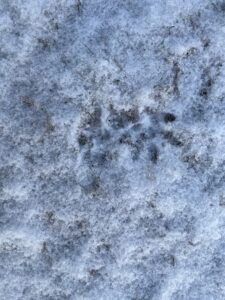
-
note splayed fingers
-
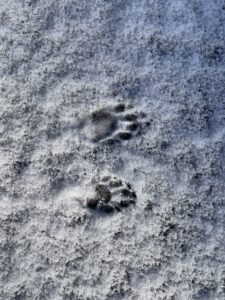
-
Raccoon paws are more like hands.
The possum wasn’t alone. We also discovered that a coyote had passed through our yard, deer had lingered a while and checked out the bird feeder, and a house cat visited, probably seeking a tasty mouse for dinner. We found mouse tracks but no evidence that one of these tiny rodents became the cat’s dinner. Sometimes a fox trots by.
-
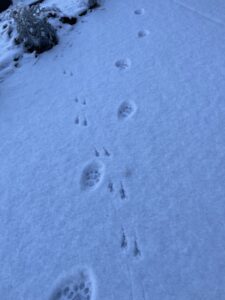
-
Hunting
-
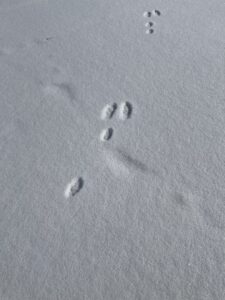
-
Distinctive tracks
-
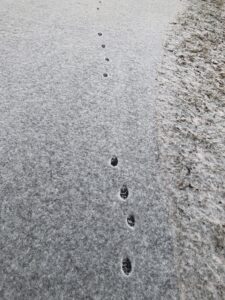
-
Fox usually trot with one paw in front of the other.
Although we have written about tracking before, we find that tracking is fascinating and a good way to enjoy winter outdoors. A light snow creates perfect conditions. The Old Farmer’s Almanac posts a useful guide on how to identify animal tracks. We are happy to re-discover our possum’s presence.
-
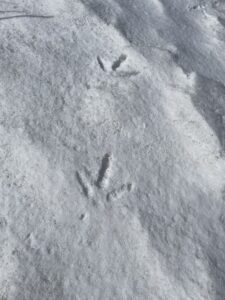
-
Three-pronged turkey tracks.
-
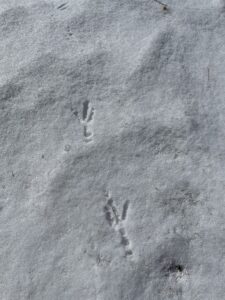
-
Easy to spot
-

-
Distinctive








 For many years a coyote pair maintained a den and raised litters of pups in a den about 300 yards from our house. We don’t see them often but spot their tracks crossing our lawn after a new snow. Every once in a while, a distant ambulance or police siren warns motorists to pull over. Often “our”
For many years a coyote pair maintained a den and raised litters of pups in a den about 300 yards from our house. We don’t see them often but spot their tracks crossing our lawn after a new snow. Every once in a while, a distant ambulance or police siren warns motorists to pull over. Often “our” 
















